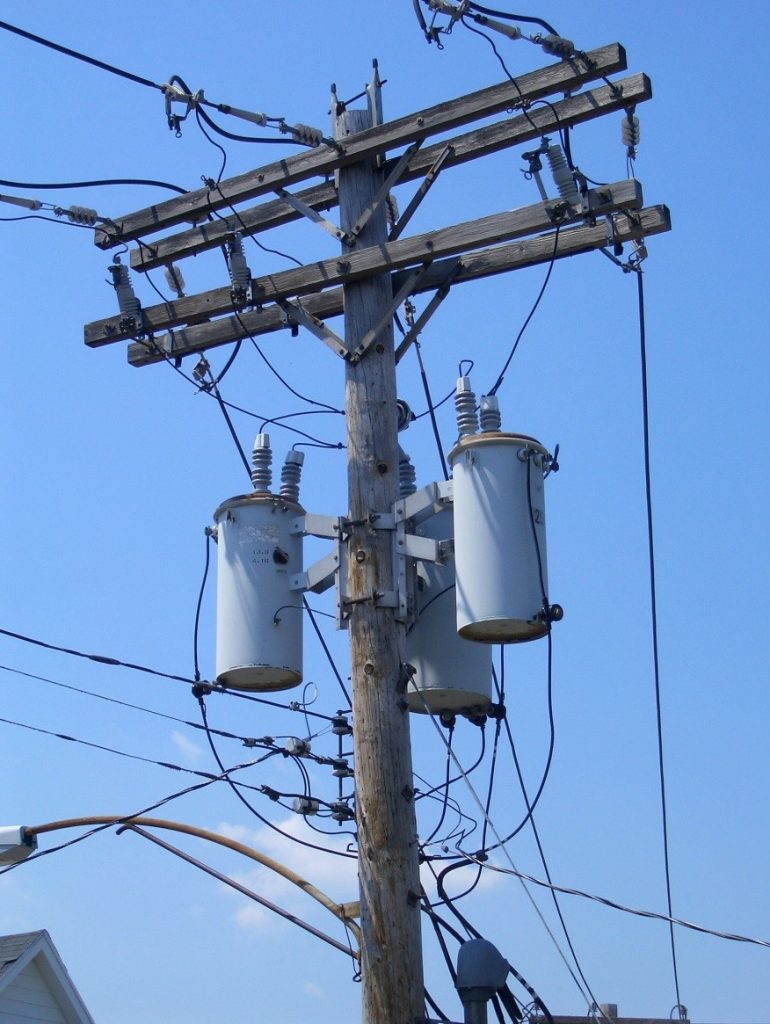
To listen to this reflection as a podcast, click here.
Have you ever wondered what’s happening inside those gray canisters hanging near the tops of utility poles?
Those are transformers – not to be confused with Autobots and Decepticons, the shape-shifting robots who used to be mere toys but now wage war in exceedingly loud movies.
A transformer is a specialized device that converts electricity of one voltage into another voltage. Voltage, as you perhaps once learned in order to pass a test back in high school, is a measure of the electric force that “pushes” electrons around a circuit.
Power plants send out electricity at extremely high “pressure” – up to 765,000 volts – so it can travel hundreds of miles along wires. But that’s way too “hot” for your coffee maker, which would quickly be dispatched to Appliance Heaven if you plugged it into such a raging stream of power.
Therefore the voltage needs to be “stepped-down” through a series of transformers.
At a power substation, the current travels through coils wrapped around an iron core. Magnetic force drops the energy to about 7,200 volts.
By the time the current reaches your neighborhood, it needs to be stepped-down again. Up on a pole in one of those gray boxes – or perhaps in a big box on the ground – the electricity is transformed to 220 volts for major appliances or 110 volts for almost everything else.
In short, a transformer takes a dangerous torrent of energy and converts it into something helpful and productive.
Which is the very reason God calls all of us to be transformers.
Relying on our own strength and wits, we’re no better than bare electric wires. Whatever comes into us is what pours out of us.
Someone snipes at me; I snipe back. Someone calls me a name; I call them a more clever name. Someone hits me with a wall of anger; I push it right back into their face. Or worse: I pass it on to the next person I meet or my family members when I get home.
Father Richard Rohr points out that if we do not transform our pain, we will always transmit it. We will pass on whatever level of negative energy has been thrust upon us.
Whenever you feel a surge of irritation welling up inside you, or experience the overwhelming need to judge someone or put them in their place, it’s likely you’re being a transmitter of pain and not a transformer.
So what does relational transforming look like?
You’re on the receiving end of a neighbor’s high-voltage anger; you internalize it and respond with kindness. You work in the hearing of a team member’s endless complaining; you refuse to let it unhinge your day and offer encouragement instead. God’s call is that we “step-down” the anxiety that comes our way and transform it into grace.
Easy to say. Hard to do.
In fact, the only way we can become transformers is if we ourselves are transformed. And the only way that will happen is if we yield our hearts to ongoing renovation by the primary Transformer.
Christians believe that Jesus of Nazareth has embodied that role like no one else in history.
Jesus took everything thrown at him – misunderstanding, betrayal, cynicism, abandonment, torture, and execution – and transformed it. “Behold the Lamb of God, who takes away the sins of the world” (John 1:29). The high voltage of human anger, hatred, and sin were stepped-down into the grace and forgiveness that are at the heart of the Good News.
That’s something to remember the next time you catch sight of one of those gray transformer cannisters.
And notice that the utility pole supporting it sure looks like a cross.
